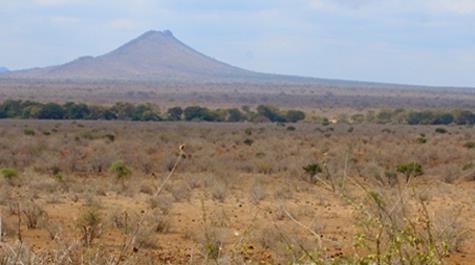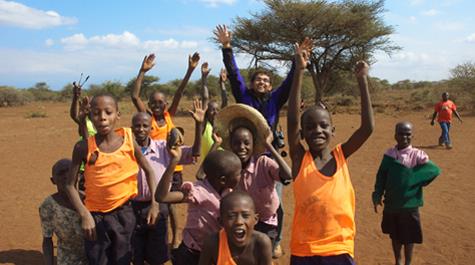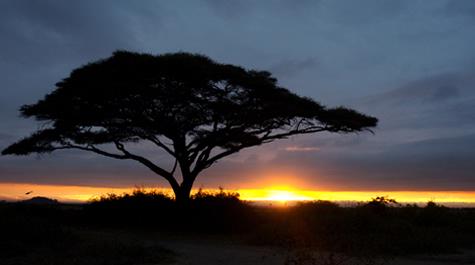Patel among the Maasai
He may not be the king of beasts, but Roshan Patel seems to have found his place in the circle of life.
"Kenya literally felt like The Lion King every day, with a big sunrise behind the acacia tree and lions and elephants everywhere," said Patel.
Patel, a member of the class of 2008 at the College of William and Mary, spent seven weeks of the summer of 2007 in the middle of this untamed scenery, teaching Maasai elementary children the basics of digital photography in the hopes that they will continue to document their richly biodiverse, almost untouched environment. Combining his love of biology with his passion for photography, Patel taught children in the third to fifth grades to take wildlife portraits and expansive, 360-degree landscape shots with digital cameras. He also showed older children, in the sixth to eighth grades, how to record locations of wildlife sightings using global positioning systems. In his down time, Patel tagged along with elephant researchers and captured stunning and intensely personal portraits of elephants, lions, cheetahs and goshawks.
Self-taught photographer
A biology major, Patel's photography skills are entirely self-taught. During his family's frequent visits to relatives in India, Patel began experimenting with photography, and soon realized how much he enjoyed it. Patel's interest in photography began to take a serious turn after he came to William and Mary. Constantly snapping photos of wildlife in his biology courses, Patel's work drew notice from his professors, and his photographs began popping up in lectures and presentations. Then he began selling his images. With the proceeds of selling his wildlife shots, some business school event gigs and a few portraits, Patel invested in a digital SLR camera, and began to seriously consider the role of photography in his life. In January 2007 Patel approached faculty advisor Dan Cristol, associate professor of biology, with the idea for a summer conservation project.
 "I knew that I really just felt passionate about trying to work with education programs to do conservation, and I wanted to try really hard to make photography fit," Patel said. "I wanted to work on a conservation project in a country that was relatively untouched and pretty receptive to conservation work. And I do photography. So I said, ‘How do I incorporate that into it?'"
"I knew that I really just felt passionate about trying to work with education programs to do conservation, and I wanted to try really hard to make photography fit," Patel said. "I wanted to work on a conservation project in a country that was relatively untouched and pretty receptive to conservation work. And I do photography. So I said, ‘How do I incorporate that into it?'"
Patel says he was inspired in part by the documentary Born into Brothels, which depicts how director Zana Briski gave cameras to a number of children in Calcutta's red light district and taught them to expand their world through photography.
Patel wanted to get kids involved in seeing their own world through a camera lens, perhaps noticing the changing landscape and considering the value of the fauna and flora surrounding them every day. "The idea of giving them a new way to look at what they typically wouldn't notice—it was an exciting thought," said Patel.
"Originally, I was skeptical that he could pull it off, but I didn't let on—I hope," Cristol said. "I can't take much credit for this. It was completely Roshan's idea and he executed it all by himself. In my experience, student projects usually work out less wonderfully than originally envisioned, but this case was very much the opposite."
Fueled by the Charles Center
Awarded a $3,000 International Summer Research Grant from the College's Roy R. Charles Center, Patel began to look for sites for his project. He wanted to work in a place with fairly untouched habitats in a nation with an environmentally-friendly attitude. Focusing on Africa and Brazil, Patel contacted elephant researcher Hamisi Mutindo, who worked with a small Maasai village in the Rombo region of southern Kenya. Mutindo put Patel in contact with the villagers, and the local school agreed to participate in the project.
"Kenya ended up a good location because they already have a pretty good emphasis on wildlife management," Patel said. "As far as convincing people to do a conservation project, it would be a lot easier there than perhaps working with public school systems in America."
The easy part: getting cameras
Acquiring cameras for the project was unexpectedly easy. "I basically wrote a letter to Canon and they followed up on it and said they would just give me discontinued cameras that weren't going to be sold anyway," said Patel. The digital cameras donated by Canon even came with a lifetime warranty. "It was actually really simple, and surprisingly less paperwork and meetings than I had thought it would take."
Armed with his ten Canon digital cameras, Patel boarded a plane for Africa in late June, eventually arriving in a mud-hut village near the Tanzania border, an hour and a half from the nearest electricity. The villagers, he said, are nomads and don't give names to their villages.
"It was literally the most middle of nowhere I'd ever been," he said. For the first two weeks of his project, Patel worked without the cameras, ensuring the village school's commitment to the project, but he said it didn't take much to get everyone completely on board and excited about the project.
The digital cameras introduced a very different experience for children who had never lived with electricity before. At first, the children were almost too excited about the project.
"Initially it was very hard to work with them, to be honest," Patel said. "We'd take the cameras out just to practice the actual features on the camera, and they would take six hundred, seven hundred pictures in a day, just firing it whenever they saw anything."
Focusing on focusing
Eventually, the novelty of the cameras began to wear off, and the children began to focus on the actual quality of the pictures they took. The group learned to take panoramic images from the tops of hills and practiced their photography techniques on a convenient (and patient) genet cat, a nocturnal animal that sat perfectly still in a tree most of the day.
The village school keeps possession of the cameras, the digital photographs and the specific GPS locations of wildlife encountered on field trips. Patel hopes that this data might allow the children to see firsthand the effects any future development or agriculture might have on wildlife populations and landscapes profiles. This project also gave the village a solid set of wildlife counts to support a petition for wildlife reserve status, should they choose.
"The other element of why I decided to do this project was because I think that people are disconnected from conservation efforts. Especially after talking to a lot of people down there, I realized that a lot of conservation is seen as ‘white people's work,' where foreigners come in and tell the tribes what to do with their land," he said. It's not that they're questioning the importance of conservation itself, but there's a kind of lack of ownership over the process."
A question of conservation
Despite his hope that the Maasai village will embrace the cause of protection of their wild and relatively pristine surroundings, Patel intends to approach the rest of this project, and possible future projects, with a hands-off attitude.
"I don't think any individual can convince everybody that conservation is an important thing to do. It's something they have to understand for themselves. Hopefully I can assist them getting there, but I don't want to be overbearing in my role," said Patel.
The wider acceptance of environmentalism is a big focus for most scientists, and Patel is no exception. "Right now, I'm thrilled that on any given day on the news you'll see some environmental issue being brought up, because the push in general is to have people thinking about it, for them to have it on the forefront of their minds," he said. "I'd like to take environmentalism out of classrooms, or if it is involved in classrooms, it should be involved in a more fun and local way. I think ultimately people need to relate to the field if they're going to care about it."
When asked about his future plans, Patel expressed an interest in bringing his experience home. He had initially looked to initiate a similar program on the Eastern Shore of Virginia, but the logistics of the U.S. school system required a greater time commitment than he had to offer.
"Maybe next year," he said. "You don't necessarily have to go somewhere dramatic to be able to do something like this. I want to make the sciences more accessible, using a pretty straightforward tool."

















